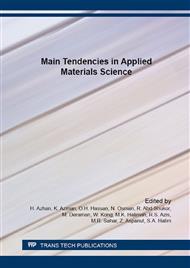p.665
p.673
p.679
p.683
p.690
p.697
p.702
p.706
p.712
Synthesis of Waste Cooking Oil-Based Polyol Using Sugarcane Bagasse Activated Carbon and Transesterification Reaction for Rigid Polyurethane Foam
Abstract:
This study was carried out to determine the potential of waste cooking oil (WCO) in preparation of rigid polyurethane (PU) foam. The raw WCO was first filtered and adsorbed by using sugarcane bagasse activated carbon in order to purify the oil. Next, the adsorbed WCO was used to synthesize polyol via transesterification reaction. The WCO-based polyol was then combined with other chemicals at various ratios to form PU rigid foam. The adsorbed WCO showed the decrease in both free fatty acid percentage and viscosity, from 4.3 % to 0.77 % and from 106 mPa.s to 72.5 mPa.s, respectively. No alteration of functional group observed after adsorption as proven by FTIR spectroscopy. The FTIR spectrum of WCO-based polyol showed the formation of OH absorption peak and supported by the increase in hydroxyl value from 0 to 148.79 mgKOH/g after reaction. The formation of urethane linkages (NHCO) backbone in PU foam was confirmed using FTIR. The properties of PU foam are highly dependent on the chemical composition. The density and compressive strength of 60:54:90:40 of glycerol:water:polyol:amine polyurethane foam are 277.7 kg/m3 and 0.10 MPa, respectively. This study showed that WCO exhibit promising potential as raw material for PU formation.
Info:
Periodical:
Pages:
690-696
Citation:
Online since:
March 2016
Price:
Сopyright:
© 2016 Trans Tech Publications Ltd. All Rights Reserved
Share:
Citation:


